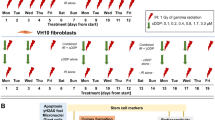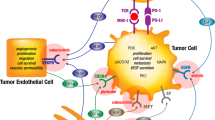Abstract
The development of resistance to vincristine, actinomycin D and cisplatin has been examined in a human epidermoid lung carcinoma xenograft line (HXL 55) growing in nude mice. Treatment of HXL 55 with 1 mg kg-1 vincristine or 0.5 mg kg-1 actinomycin D once in each in vivo passage resulted in a rapid reduction in tumour responsiveness to these drugs. A partial resistance was already acquired at the 2nd transplant generation. In contrast, a gradual decrease in therapeutic response was observed with 10 mg kg-1 cisplatin. Irradiation with a local dose of 10 Gy induced no resistance. The three induced drug-resistant sublines were characterized in terms of the time course of development of resistance, the degree of induced resistance, cross-resistance, growth rate and stability of the phenotype.
This is a preview of subscription content, access via your institution
Access options
Subscribe to this journal
Receive 24 print issues and online access
$259.00 per year
only $10.79 per issue
Buy this article
- Purchase on Springer Link
- Instant access to full article PDF
Prices may be subject to local taxes which are calculated during checkout
Similar content being viewed by others
Author information
Authors and Affiliations
Rights and permissions
About this article
Cite this article
Mattern, J., Bak, M., Hoever, K. et al. Development of drug resistance in a human epidermoid lung carcinoma xenograft line. Br J Cancer 58, 30–33 (1988). https://doi.org/10.1038/bjc.1988.155
Issue Date:
DOI: https://doi.org/10.1038/bjc.1988.155



